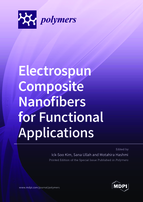Electrospun Composite Nanofibers for Functional Applications
A special issue of Polymers (ISSN 2073-4360). This special issue belongs to the section "Polymer Applications".
Deadline for manuscript submissions: closed (28 February 2022) | Viewed by 32274
Special Issue Editors
Interests: nanofibers; electrospinning; bio-medical; sensors; carbon materials; food packing; nano-catalysis; supercapacitor; drug delivery
Special Issues, Collections and Topics in MDPI journals
Interests: nanofibers; electrospinning; polymers; biomaterials; biomedical; environmental; wound dressing; drug delivery; wastewater treatment; filtration; membranes; face masks; sensors
Special Issues, Collections and Topics in MDPI journals
Interests: nanofibers; electrospinning; polymers; wound dressing; biomedical; drug delivery; antibacterial; antiviral; filtration; membranes; face masks
Special Issues, Collections and Topics in MDPI journals
Special Issue Information
Dear Colleagues,
Electrospun nanofibers have a wide range of applications covering almost every field of science and technology. Polymeric materials, either from natural sources or synthetic polymers, are the basis for such applications. However, researchers are still facing challenges in processing complex polymers to transform them into nanofibers to maximize their practical applicability. Considering the potential of polymeric nanofibers (produced by either technique) in biomedical, environmental, filtration, electronics, and other fields, it is vital for the researcher community to actively contribute in these areas. This Special Issue of Polymers MDPI on “Electrospun Composite Nanofibers for Functional Applications” will cover the abovementioned areas of electrospun nanofibers. Research relevant to recent advances in nanotechnology, especially electrospinning technology, to produce nanofibers with complex structures, unique characteristics, and potential in practical applications will be a priority for this Special Issue.
Prof. Dr. Ick-Soo Kim
Dr. Sana Ullah
Dr. Motahira Hashmi
Guest Editors
Manuscript Submission Information
Manuscripts should be submitted online at www.mdpi.com by registering and logging in to this website. Once you are registered, click here to go to the submission form. Manuscripts can be submitted until the deadline. All submissions that pass pre-check are peer-reviewed. Accepted papers will be published continuously in the journal (as soon as accepted) and will be listed together on the special issue website. Research articles, review articles as well as short communications are invited. For planned papers, a title and short abstract (about 100 words) can be sent to the Editorial Office for announcement on this website.
Submitted manuscripts should not have been published previously, nor be under consideration for publication elsewhere (except conference proceedings papers). All manuscripts are thoroughly refereed through a single-blind peer-review process. A guide for authors and other relevant information for submission of manuscripts is available on the Instructions for Authors page. Polymers is an international peer-reviewed open access semimonthly journal published by MDPI.
Please visit the Instructions for Authors page before submitting a manuscript. The Article Processing Charge (APC) for publication in this open access journal is 2700 CHF (Swiss Francs). Submitted papers should be well formatted and use good English. Authors may use MDPI's English editing service prior to publication or during author revisions.
Keywords
- polymers
- biomaterials
- nanomaterials
- nanofibers
- electrospinning
- biomedical
- drug delivery
- filtration
- membranes
- face masks
- sensors
- food packaging









